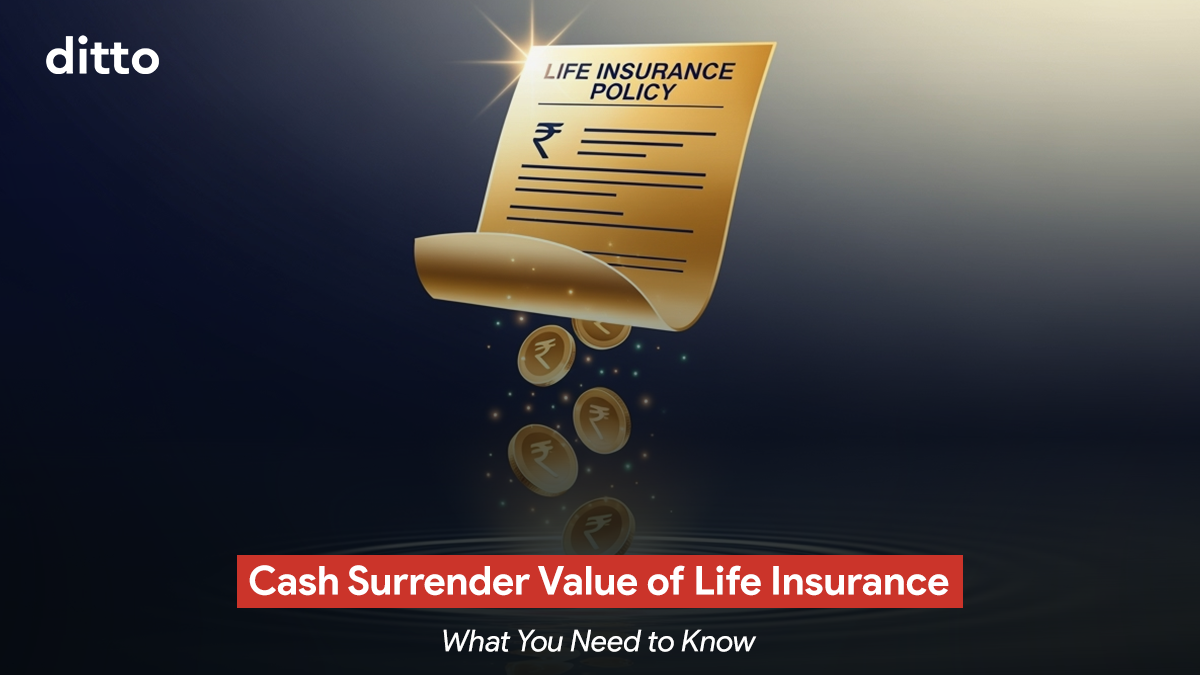| What is the Cash Surrender Value of Life Insurance? The cash surrender value of life insurance is the amount a policyholder receives if they decide to terminate their life insurance policy before maturity or the insured’s death. This value represents the savings or investment component of the policy, minus surrender charges, outstanding loans, or withdrawals. But it's important to note that surrendering a policy cancels coverage and death benefit protection. |
Life is unpredictable, and having a life insurance policy provides peace of mind. But if you’re thinking about discontinuing your policy before it matures, it’s important to understand the cash surrender value of life insurance, which is the amount your insurer pays if you cancel the policy early.
However, surrendering your policy doesn’t always guarantee a fair payout. The amount you receive can be significantly lower than expected, depending on factors such as your policy type, how long you’ve held it, and the premiums you’ve paid.
So, how can you determine whether surrendering your life insurance is the right choice? In this guide, we break down everything you need to know about the cash surrender value of life insurance to help you make an informed decision.
Still unsure about which insurer to choose? Book a free consultation with an expert Ditto advisor. No pressure to make a purchase, just honest guidance.
How Does Cash Surrender Value Work?
As the policyholder pays premiums, a portion is allocated to a savings or investment component, gradually building cash value over time. If the policy is surrendered, the insurer pays the accumulated cash value, minus any surrender charges, outstanding loans, or prior withdrawals. These deductions are highest in early years and decrease over time. One more thing of note is that the payout may be subject to taxes if it exceeds the premiums paid.
| Did You Know? For 2023–24, according to the IRDAI Annual Report, insurers paid out ₹2,29,245 crore in surrenders and withdrawals. This represents one of the most striking statistics in the Indian insurance landscape. The amount, which accounts for nearly 40% of total benefits paid, far exceeds death claims of ₹42,284 crore and is comparable to maturity payouts of ₹2,42,699 crore. |
What are the Types of Cash Surrender Values in Insurance?
There are two primary types of cash surrender values in life insurance:
1. Guaranteed Surrender Value (GSV):
It is the minimum amount payable by the insurer if you surrender. The GSV value is specifically defined under the Insurance Act, 1938 and IRDAI (Insurance Products) Regulations, 2024.
For non-linked policies (excluding single premium):
- In year 2, the GSV is 30% of premiums paid.
- In year 3, it increases to 35% of premiums paid.
- From years 4 to 7, the GSV is 50% of premiums paid.
- In the last 2 years of the policy, the GSV gradually increases to 90% or more of premiums paid.
For single premium policies:
- In years 1 to 3, the GSV is at least 75% of the single premium.
- From year 4 onwards, the GSV is at least 90% of the single premium.
2. Special Surrender Value (SSV)
The SSV is generally higher than GSV and specifically reflects paid-up benefits and accrued bonuses. The IRDAI requires SSV to be at least the present value of
- paid-up sum assured
- paid-up future benefits
- accrued bonuses, after deducting survival benefits already paid
To sum it up, the surrender value you actually get is higher than that of a GSV or SSV.
How to Calculate Your Cash Surrender Value?
The following is the formula for the Guaranteed Surrender Value:
GSV = (Total Premiums Paid - First year premium - Premium for Riders/Bonuses - GST)* Surrender Value Factor
The Surrender Value Factor is typically considered as a percentage of the total premiums paid and is often set at 30%.
The following is the formula for Special Surrender Value:
SSV = [{(Number of premiums paid/Total number of premiums) * Sum Assured} + Accrued bonus] * Surrender Value Factor (SVF).
Remember: Subtract any surrender charges, policy loans, and applicable deductions. Each insurer provides detailed surrender value factors and applicable bonuses, and many offer online surrender value calculators for convenience.
Simplified Example of a Surrender Value
Consider a policyholder with the following details:
- Sum Assured: INR 10,00,000
- Policy Term: 20 years
- Annual Premium: INR 50,000
- Total Premiums Payable: INR 10,00,000
- Premiums Paid So Far: 8 years (INR 4,00,000)
- Accrued Bonus: INR 1,20,000
- Surrender Value Factor: 30% for GSV, 50% for SSV
Guaranteed Surrender Value (GSV) Calculation:
- GSV = (INR 4,00,000 – INR 50,000) × 30%
- GSV = INR 3,50,000 × 30% = INR 1,05,000
Special Surrender Value (SSV) Calculation:
- SSV = [{(8/20) × INR 10,00,000} + INR 1,20,000] × 50%
- SSV = [INR 4,00,000 + INR 1,20,000] × 50%
- SSV = INR 5,20,000 × 50% = INR 2,60,000
Final Payout: Since the insurer pays the higher value between GSV and SSV, the policyholder will receive INR 2,60,000 as the surrender value.
Factors to Consider While Calculating Surrender Value
When calculating the surrender value of a life insurance policy, key factors to consider include:
- Accrued Bonuses: Participating policies accumulate bonuses over the years, enhancing the surrender value significantly compared to non-participating policies.
- Type of Policy: Endowment and ULIP plans build cash value, allowing surrender benefits, while term insurance offers no surrender value as it lacks a savings component.
- Premium Paid and Frequency: Higher premiums and frequent payments contribute more towards the policy, increasing its surrender value over time.
- Policy Term and Duration: The longer you hold the policy, the more it accumulates, leading to a higher surrender value. Early surrender results in lower payouts due to policy penalties.
Bottom Line: These elements, together, determine the final surrender value available if a policyholder decides to terminate their policy early.
Why Do Policyholders Surrender?
The root causes behind this behavior are quite complex and multifaceted. These include:
- Financial Distress and Liquidity Needs: Policyholders may face unforeseen emergencies such as job loss, medical crises, or high inflation. These situations can make it difficult to continue paying premiums or create urgent cash needs.
- Mis-selling and Unsuitable Products: Some insurance agents, motivated by high upfront commissions, sell products that do not align with a customer’s financial goals, risk appetite, or ability to pay long-term premiums. When policyholders later realize the product’s high costs, inflexibility, or low returns, dissatisfaction often leads to surrender.
- Poor Policy Performance and Mismatched Expectations: Unit-Linked Insurance Plans (ULIPs) are particularly susceptible to surrender, as their returns depend on market performance. Volatile markets or unrealistic return expectations set during sales can cause policyholders to view the policy as a failed investment rather than long-term protection, leading to surrender.
- Evolving Needs and Better Alternatives: Life events such as marriage, childbirth, or changes in income can make existing policies inadequate. Policyholders may find more suitable or cost-effective products, such as term insurance plans, prompting them to surrender older policies in favor of new ones.
Which Types of Policies Have Cash Surrender Value?
| Product Type | Applicability of Surrender Value | Guaranteed Surrender Value (GSV) | Special Surrender Value (SSV) | Key Conditions & Notes |
| Pure Term (non-linked) | Generally not required to provide a surrender value (pure risk cover only). | Not applicable | Not applicable | No GSV/SSV unless explicitly designed with return features. Limited pay plans or plans with special exit features may acquire surrender value for a specific number of years. |
| Immediate Annuity (non-linked pension) | No surrender value mandated. | Not applicable | Not applicable | Lump sum is immediately converted to annuity; surrender is not allowed. |
| Deferred Annuity (non-linked pension) | Must acquire a GSV. | After 2 years’ premiums: 30% (yr 2), 35% (yr 3), 50% (yrs 4–7), progressing to ≥90% in last 2 yrs; single premium: ≥75% (yrs 1–3), ≥90% from yr 4. |
Higher of GSV or actuarial SSV (PV of paid-up sum assured, paid-up benefits, accrued benefits). | On surrender/vesting: options include (i) full annuity purchase, (ii) commutation ≤60% + annuity, (iii) portability up to 50% to another insurer. If proceeds are too small for minimum annuity, lump sum allowed. |
| Endowment / Money-back (non-linked savings) | Must acquire GSV. | Same GSV rules as above. | Higher of GSV or SSV. Bonus/GA surrender values must be added. | Once surrender value acquired → policy cannot lapse, continues as paid-up. If the paid-up benefit is too small, it can be terminated by paying SV. |
| Whole Life (non-linked savings) | Must acquire surrender value. | Same GSV/SSV rules as endowment. | Same as above. | Paid-up rule applies once SV acquired. |
| ULIPs (linked, regular premium) | Subject to 5-yr lock-in. | During lock-in: unit fund value – discontinuance charges, moved to Discontinued Policy Fund (DPF), payout only after lock-in. | Not separately defined; surrender value is at least fund value after lock-in. | Discontinuance charge caps apply (nil after yr 5). DPF earns ≥IRDAI-declared minimum (currently 4%). |
| Did You Know? As per the IRDAI Master Circular on the protection of policy holders interest, all surrender, partial withdrawal requests should be processed within 7 days of receipt of request. |
Ditto’s Take on Cash Surrender Value of Life Insurance
Surrendering a life insurance policy can significantly impact your financial planning, so maximizing your surrender value is crucial. In that case, you can take this cash surrender value decision framework into consideration:
Step 1: Check Policy Details
First, identify your policy type: whether it is a term plan, endowment, money-back, ULIP, pension plan, or another type. Review the benefit illustration carefully to understand the maturity value, surrender value, and paid-up value of the policy.
| Quick Note: A paid-up policy occurs when you stop paying premiums after the policy has acquired a surrender value, but instead of cancelling it, you let it continue in a reduced form. The policy stays in force without further payments, with a reduced sum assured and maturity benefits. The death benefit (though lower) is still payable, while bonuses may stop accruing. This allows you to retain some coverage without surrendering the policy. If you plan to buy a term plan, ensure it is issued successfully before surrendering your existing policy and declare all current or past life insurance plans during the purchase. |
Step 2: Assess Financial Commitment
Consider the percentage of total premiums you have already paid:
- If less than 30% of premiums are paid and more than seven years remain, it is usually better to cut losses and surrender the policy.
- If 30–80% of premiums are paid, the decision depends on the number of years left and a comparison of surrender versus paid-up value.
- If more than 80% of premiums are paid, it is generally advisable to continue the policy until maturity.
Step 3: Consider the Remaining Policy Term
- If more than 7 years remain and you have paid a low percentage of premiums, surrendering and reinvesting may be the best option.
- If 3–7 years remain, opting for a paid-up policy is often better, as it allows you to retain some benefits without paying additional premiums.
- If 2–4 years remain, you can either continue or convert to paid-up status depending on your liquidity needs.
- If less than 2 years remain, it is usually better to continue the policy, since you are close to maturity.
The following illustration shows premiums, benefits, and surrender values (GSV and SSV) year by year.:
Step 4: Analyze Your Personal and Financial Needs
- Assess whether you can comfortably continue paying premiums without financial stress.
- Determine if you need immediate liquidity (cash) or if you can wait.
- Consider whether you already have adequate term insurance coverage elsewhere.
Step 5: Check Out the Policy Benefits
- Compare the surrender value with the paid-up value to understand which option is more beneficial.
- Check whether bonuses will stop accruing if you convert the policy to paid-up status.
- Explore whether a policy loan is available as an alternative to surrendering, especially if you need liquidity.
Would Surrendering Reduce Your Family's Financial Security?
Before deciding, check if you have sufficient alternative life insurance coverage, such as a term plan, to protect your family.
Rule of Thumb:
- If you need cash urgently, consider surrendering the policy.
- If you do not want to pay further premiums but do not need immediate cash, consider converting the policy to paid-up status.
- If you are close to maturity or have already paid a significant portion of premiums, it is usually best to continue the policy until maturity.
Why Choose Ditto for Health Insurance?
At Ditto, we’ve assisted over 8,00,000 customers with choosing the right insurance policy. Why customers like Abhinay love us:

Surrender Value of Life Insurance: Final Thoughts
Surrendering a life insurance policy is a significant financial decision that should be approached with careful consideration. While it can provide immediate liquidity, it also comes with long-term drawbacks, such as loss of coverage, reduced payouts, and potential tax implications. Before surrendering, assess whether alternatives like policy loans or converting to a paid-up policy can better serve your financial needs.
Ultimately, the right choice depends on your financial goals, current situation, and the specific terms of your policy.
Still unsure about which insurer to choose? Book a free consultation with an expert Ditto advisor. No pressure to make a purchase, just honest guidance.
FAQs
Is the cash value of life insurance taxable when surrendered?
The tax treatment of surrender value depends on the type of policy, its duration, and whether it meets the conditions under Section 10(10D) of the Income Tax Act. The surrender value is tax-free if the annual premium does not exceed 10% of the sum insured (or 20% for policies issued before April 1, 2012). However, if the premium surpasses this threshold, the surrender value is added to the policyholder’s income and taxed as per their applicable slab rate.
Do all life insurance policies offer a surrender value?
No, not all life insurance policies offer a surrender value. Term insurance plans, for example, do not provide any surrender value as they only offer pure risk coverage. Traditional savings-based policies like endowment or whole life plans usually acquire a surrender value after a minimum premium payment period, often three years.
When does a life insurance policy become eligible for a cash surrender value?
A life insurance policy becomes eligible for surrender value after completing a minimum lock-in period, which typically ranges from 2 to 5 years, depending on the type of policy.
Why do people surrender their life insurance policies?
Policyholders may surrender life insurance due to shifting financial priorities, such as debt repayment or funding major goals. Others find the premium burden unsustainable or prefer redirecting funds into higher-return investments. In some cases, coverage is no longer needed once dependents become financially independent.
What happens if a policyholder stops paying premiums?
If a policyholder stops paying premiums and exceeds the grace period, the life insurance policy typically lapses, meaning the coverage ceases, and the benefits are no longer available. However, many insurers offer a revival option within a specified timeframe, allowing the policyholder to reinstate the policy by paying overdue premiums along with any applicable penalties or interest.
When is the right time to surrender a policy?
The right time to surrender a policy depends on whether it aligns with your long-term financial goals and if the surrender value outweighs other available options. Comparing it with alternatives like loans or investments can guide a better decision. Instead of surrendering, policyholders may consider a loan against the policy, converting it into a paid-up plan, or adjusting premiums to retain some benefits.
What is the cash surrender value process?
The cash surrender value process is quite straightforward. The steps include:
- Visit the insurer's branch (many require physical surrender requests despite online calculators).
- Keep ID proof, policy bond, and bank details ready.
- Clarify processing time and final payout.
Last updated on:







